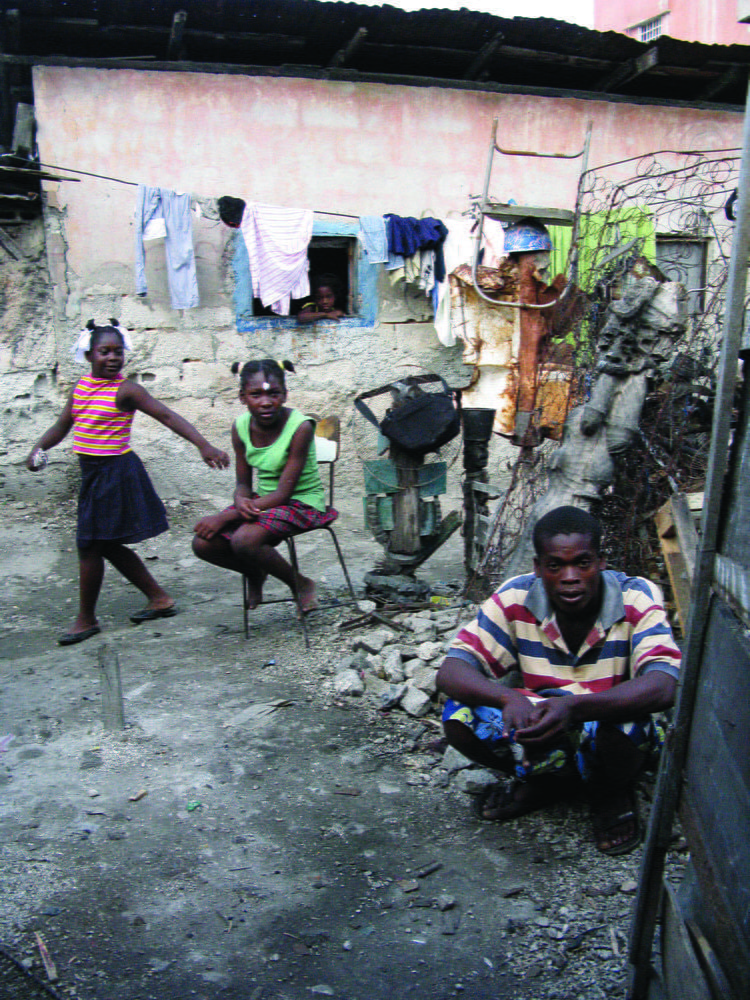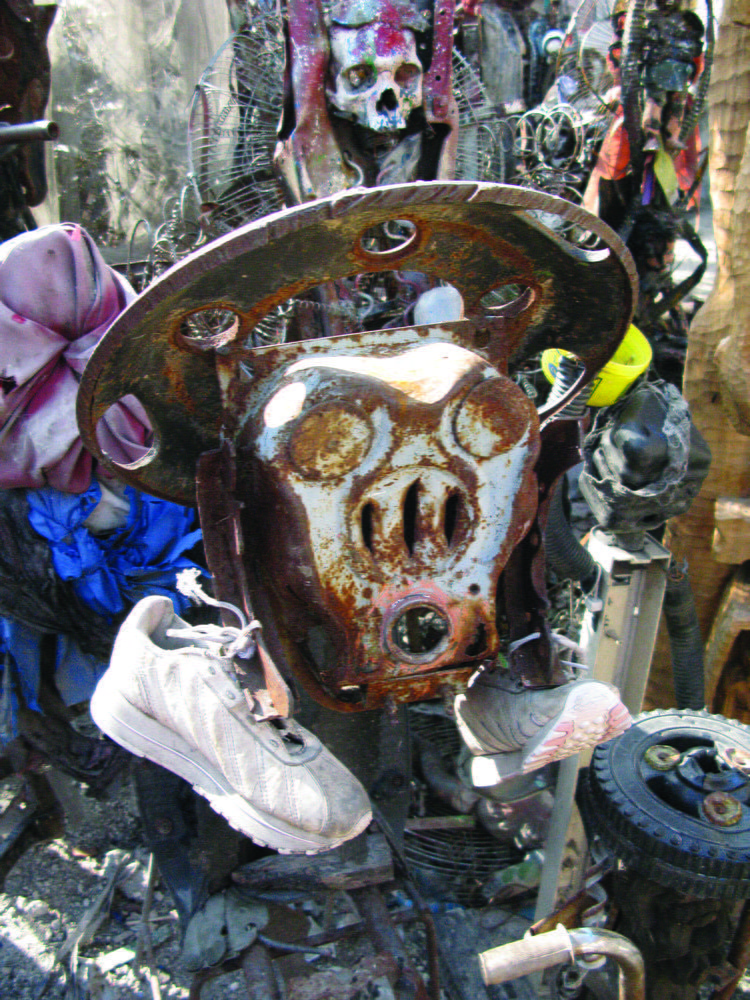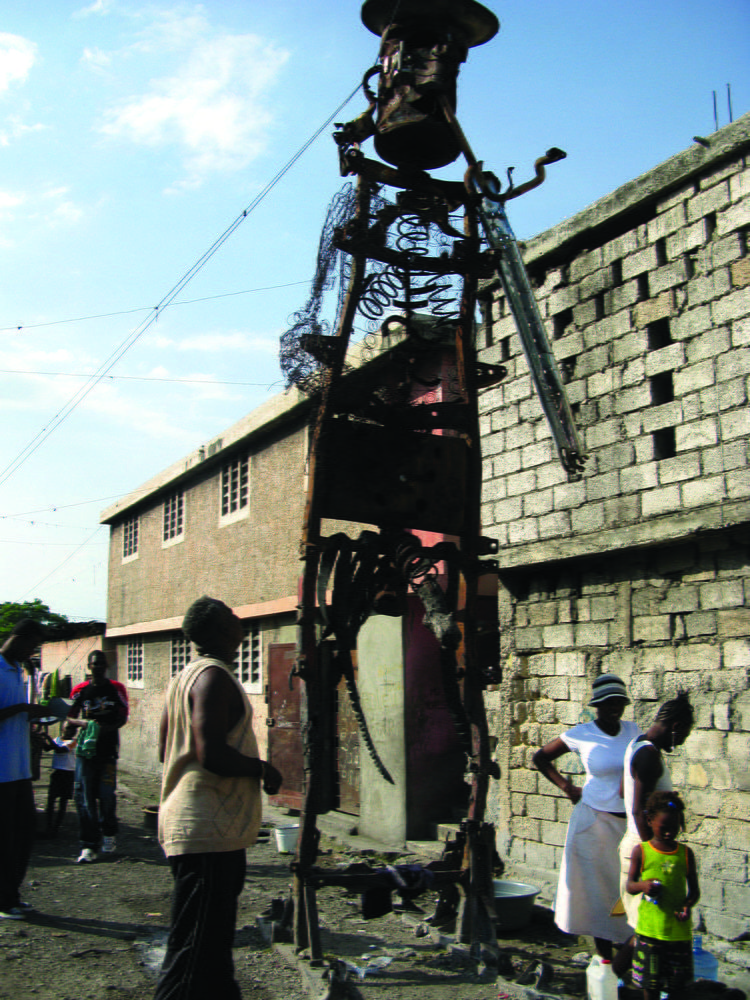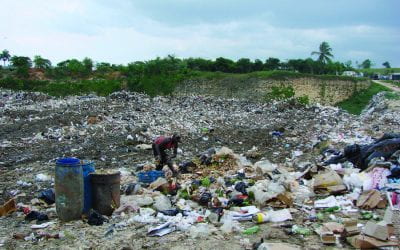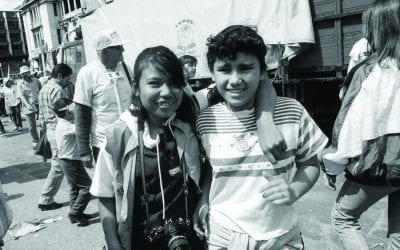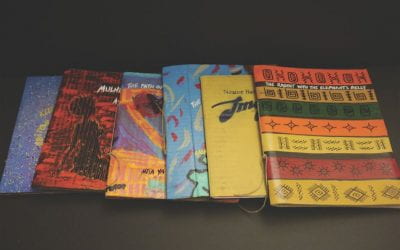Haiti in the Time of Trash
Recycling, Rebuilding, and Remaining Joyful Five Years After the Earthquake
André Eugène is perched on a corroded tin box inside his downtown Port-au-Prince studio on Grand Rue, demonstrating his hammering technique on a scrap of rubber. Droplets of sweat dance and glimmer on his forehead as he works. He is barefoot, clad only in black shorts and several pieces of beaded, woven and metal jewelry that encircle his neck, wrists and fingers.
“ I get more inspiration working with recycled materials because those pieces are unique and can’t be duplicated,” says Eugène, a senior member of Artis Rezistans—a community of artists who work solely in the medium of garbage.
The narrow 14 x 5-foot cement studio is brimming with items of his handiwork, ranging in price from $50 to $50,000 for some of the larger pieces that take over a month to complete. A metal skull, balanced atop a wooden block, grins at me from the corner. One red and one green Christmas light flickers merrily in each of its eye sockets, and it is crowned with a cowboy hat fashioned from tire rubber. Several bottles of Argentinean vino blanco are holding court around the base of the sculpture’s perimeter.
The artists work with whatever materials they can pick up off the streets: metal, wood, nails, cracked CDs, tires, bottle caps and dismembered dolls. Eugène says that he’s partial to metal, which has become more and more difficult to find because of the clean-up initiative by the city. When I ask him if part of him wishes there were no such effort underway, he answers: “No. When you have clean streets you have good health, and that is the most important thing.”
One of Eugène’s students, Patrick Ellie, then leads me around the corner to his cavernous studio on Rue Bois. He is wearing paint-splattered jeans and a droopy beanie with an oversized pompom that bobs behind him as he walks. Ellie’s studio is broken up into a maze of rooms: in one, a man is reclining on a wooden chopping block; in another, a slim woman is modeling paper handbags on the crook of her arm; in a third, dubbed the “inspiration room,” there are piles of bicycle parts, air conditioners, tires, and metal scraps. One lone doll head, sporting a radiant orange bob, sits atop a smashed plastic basket.
Three young boys are darting in and out of the rooms, making sure not to miss out on any of the action. “André is a person who loves to help children,” Ellie says as the kids run underfoot. He tells me that his favorite material is rubber from car tires. He shows me his first recycled creation, a wall hanging made out of rubber that is an abstract representation of the Holy Trinity. When I ask him why he chooses to work in the medium of trash, he replies, “It gives respect to my city to use the garbage. It shows that everything can be used, and nothing was lost.”
A few weeks earlier, I had been at the Massachusetts Institute of Technology, discussing recycling and rebuilding with Jan Wampler, professor of architecture, and Gerthy Lahens, a Haitian-American former research fellow, social activist, and founder of the non-profit Haiti Renaissance. My volunteer-run organization, Charitable Confections, is partnering with Haiti Renaissance and the Port-au-Prince-based Haiti Scholarship Association to build a 6,500-square meter campus in the capital’s poorest slum, Cité Soleil. Wampler plans on constructing the multi-building lot, which will include primary, secondary and vocational schools, entirely out of bamboo—a material that is both durable and renewable, as it grows quickly—and that doesn’t generate waste when sourced. Wampler is keen on doing whatever it takes not to generate refuse, as well as on creatively utilizing what already exists. Some of the ways that Wampler has recycled debris in the past has been to form crushed concrete into hills and mountains, and to place extraneous bits of stone and brick inside wire cages to use as outside support for walls of buildings.
“Two hundred years ago, people didn’t throw away things,” he said, shaking his head. “My team always examines every piece of debris and tries to figure out how it might be best used. Dumping it in someone else’s backyard isn’t an option.”
A couple of days later, during my follow-up phone call with Lahens, she exclaims: “Garbage in Haiti has become political!” I laugh, thinking she’s joking, but then I hear her indignant “Yes!” on the other end, and I realize that she’s serious. She tells me that some neighborhoods in Port-au-Prince have entered into an unofficial competition to claim the title of the most garbage-strewn, on the assumption that wealthy foreigners will be so moved by their dire situation that they will open their wallets to provide financial aid. While Lahens acknowledges that the local government officially condemns such behavior, she says, “Actions speak louder than words. They’re not doing enough to enforce the laws.”
A few days after my visit to Artis Rezistanz, Lahens’ friend, Samuel Bernard, a twenty-something Haitian who is part of the extended Haiti Renaissance team, takes me to Carrefour, a residential commune on the outskirts of Port-au-Prince, to meet recycled charcoal crafter extraordinaire, Sony Desir, in his open-air atelier. Desir is part of Federation Inter-Regionale des Organisations (FIROPAP), a non-profit whose mission statement is “to contribute to the reconciliation of the Haitian men with their environment in a logical way to develop an economy which is sustainable.”
While regular charcoal consists mostly of pure carbon, made by cooking wood in a low oxygen environment, the recycled briquettes are made from a porridge of paper waste, water, sawdust, and clay, plus a “special” ingredient that is poured into cylinders to extract the water and form circular briquette disks, which are three inches in diameter with a hole in the middle.
When I inquire about the mystery ingredient, Desir tells me he has an “important room” to show me. He leads me to an alley at the back of his workshop that is overrun with prickly branches and rotting logs and has a row of six plump garbage bags fastened with meticulous topknots. He kneels before one of the garbage bags, unties the knot, and peels back the plastic to reveal the autumnal-hued leaves stuffed inside. “Voila!”
I’m somewhat disappointed by his revelation, as I was hoping for something more exotic and flamboyant, but I smile and say “Oh, wow,” and get to the business of obtaining exact recipe measurements for the porridge.
Desir provides them to me without including the leaves. I inquire about them and he tells me that it’s not necessary to measure them because he knows by instinct, but when Bernard sums up the process as being an improvised, inexact one, he becomes somewhat agitated.
“Why don’t we say that although there is no exact quantitative expression for the measurement of the leaves, the amount is meticulously scooped out by the expert hand of one who has had years of experience,” I offer. Desir looks confused, so Bernard translates in Creole and gets an affirmative head bob. The matter of the leaves is settled.
Desir sells his briquettes at the extremely modest price of 50 centimes ($.01) for a set of six to local families. He tells me that his organization’s aim is not to make money, but to “raise awareness of the garbage issue and provide a solution for the problem of our environment. “ He adds that the process of turning garbage into energy also can help slow down the deforestation process in Haiti—one of the larger problems the country is facing right now—by providing an alternative means to heating homes and cooking. Clementine Lalande, Haiti country director of Yunus Social Business, founded by Nobel Prize-winning economist Muhammad Yunus, tells me that one of the primary problems of past reforestation initiatives has been that the poor in rural areas would cut down trees prematurely, because their only source of cash is often to make traditional charcoal and sell it to charcoal distributors in Port-au-Prince. The organization is currently launching a reforestation initiative in conjunction with Virgin Unite, The Clinton Foundation, and the government of Haiti.
“I encourage my friends to not cut down trees for the other charcoal!” Desir proclaims. “They can make clean streets and some money with recycled briquettes.”
In his memoir about the cleanup effort after the 2010 earthquake, entitled Collier de Debris, Haitian author Gary Victor writes: “The debris is a gaping wound in our bodies, in our souls.“ During my first visit to Haiti in 2008, the combination of the prolific trash and the dusty air, which felt so heavy, overwhelmed me and turned me off; but a year later, it was the images of debris, immediately following the earthquake, that captured my heart. One, of a young boy who had been almost entirely swallowed by a heap of concrete, with his bright red t-shirt and cognac-hued arm outstretched towards the sky, made me realize how quintessentially Haitian it was to remain colorful and defiant even in the time of tragedy.
According to Michel Bonenfant, country director of United Nations Office for Project Services (UNOPS), the organization’s debris clearing process, which removed millions of cubic meters of refuse, has officially ended. “Haiti is the world’s example for removing debris the fastest,” he says. During the emergency phase, immediately post-disaster, UNOPS repaired 800 houses and built over 1,500 shelters in the poorer neighborhoods of Port-au-Prince. He tells me that now that the organization is out of the emergency phase, it is focusing on large-scale rebuilding projects that will promote the sustainable development of Haiti.
Bonenfant later dispatches an email with more information about UNOPS’ rebuilding projects. Folded in with the text is a photo of a two-story cilantro-green home with bamboo accents. It is decorated with a mosaic of a tree with undulating branches fanning out across the lower level that is reminiscent of Gustav Klimt’s painting, Tree of Life. When I see it, I can’t help but clap with delight and think to myself “Vive la belle Haiti!”
Marcel Jean, founder of Haiti Scholarship Association, is driving me to Cité Soleil to meet with the HSA-sponsored scholars who will be the first students to be matriculated into the scholastic campus, once it has been completed. He stops the pickup truck to greet a teenage boy plucking cans from the patch of land, carpeted with trash, that is adjacent to the street. He has a large plastic bag that is half-filled with his loot, which he will take to a local recycling center, in order to receive “some very small money.”
Nearby, a young boy, draped in an oversized purple polo shirt, is playing a game of one-man Frisbee with a plastic lid. He hurls it into the air, then gallops after it, giggling. The boy catches the eye of a toddler in an emerald shirt, who has repurposed a squashed Diet Coke can into an imaginary airplane slicing through the sky in majestic loops, and he, too, begins to chase after the lid.
“Other people come to Haiti and see junkyards, but we see magical playgrounds,” Jean explains as he watches them. The children are sprinting farther and farther down the street, and have become two colorful dots on the dusty horizon, but we can still hear their voices clearly. Their peals of laughter ring like bells heralding good tidings.
Winter 2015, Volume XIV, Number 2
Linda Khachadurian is a medical and educational editor and founder of the volunteer-run non-profit, Charitable Confections, which raises awareness and funds for educational programs in developing nations.
Related Articles
Zero Waste in Punta Cana
I never imagined that my job at a leading Dominican resort would be so dirty—at least not at the beginning. I spent my first months as environmental director of…
A Long Way from the Dump
I am the oldest of five children, and from the time I was little I learned to look for toys and food in Guatemala City’s sprawling garbage dump. My grandmother raised pigs, and I had to be in…
Recycle the Classics
Literature is recycled material, a pretext for making more art. I learned this distillation of lots of literary criticism in workshops with children. I also learned…

